Moon cactus (Gymnocalycium mihanovichii) is popular as Ruby ball cactus, Hibotan cactus, Red Cap, or Red Hibotan or Star flowered cactus. Moon Cactus belongs to the genus Gymnocalycium of globular cacti.
It is a man made cactus which is a combination of two cacti grafted together. The colorful Gymnocalycium mihanovichii cactus is the top cactus and any cactus species can be the lower green cactus. The cactus ball is of size 2.5 cm to 5 cm and has ribs on it.
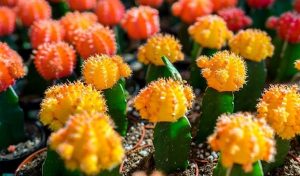
Moon cactus life span | How Long Do Moon Cactus Live
The life span of Moon Cactus is very short and it can live from one to three years. However, sometimes it can live up to five years.
A native to desert regions of South America, such as northeast Argentina, Paraguay, Bolivia, and Brazil, Moon Cactus can grow at a low height of up to 500 meters.
It was first discovered by Alberto Vojtech Fric, a Czech botanist in 1903 and was described by Max Gurke as Echinocactus Mihanovichii in 1905 and got a place in the Gymnocalycium genus in 1922.
Moon cactus lives shorter than most cacti. These grafted cacti can live for a few years only. Their short lifespan is because of the rootstock growing faster than the top part of the plant. You have to re-graft the colorful ball cactus onto the rootstock to increase their lifespan.
Appearance
Moon cactus is a grafted cactus having a colorful ball-shaped top. These colorful cacti are small houseplants that are very popular as you can easily take care of them. The cactus top is generally bright red, pink, orange or yellow in color giving it the appearance of a brightly-colored cactus flower.
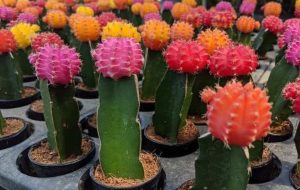
The Gymnocalycium Mihanovichii plants are very attractive with vibrant bright colors like orange, hot pink and neon yellow. This color difference is due to the lack of chlorophyll. These are small in size, usually a half-inch across.
Some of the Moon Cacti have variegated or multi-colored tops but each one has clusters of small, sharp spines throughout the curved veins.
Factors you need to keep in mind while growing Moon Cactus
You should keep certain things in mind while growing Moon Cactus. These are:
Duration of Light
This dwarf cactus requires bright light and partial shade both because it is a combination of two cacti with different needs. Place them where it can get bright light and shade both. 4 to 6 hours of sunlight is sufficient for the plant.
Moon cactus grows well in bright but indirect sunlight. Exposure of the Moon cactus to direct sunlight can harm the plant. If the plant is not getting enough bright light, the color of the plant will fade.
Temperature
They grow well at average room temperature and low humidity.
Keep these plants indoors to protect them from frost in winters otherwise the moon cactus will freeze in harsh winters.
Water requirements of Moon Cactus
Moon cactus needs water like any other succulent. In spring and summer months, water it regularly. During the winters, water it less frequently. Make sure that the soil is dry before watering the plant. Use unglazed pots with numerous drainage holes to avoid standing water at the base of the pot, which will protect the roots from rotting. Put a thin layer of gravel at the bottom of the pot as it will help in water drainage.
Soil
Moon cactus grows well in the regular soil with good drainage. You can use a mixture of pumice or perlite and regular potting soil. The soil should be rich in organic matter and should be fast draining. the pH level of the soil should be low (acidic to neutral).
Growth
Moon cacti grow slowly so you don’t have to worry about repotting.
Moon Cacti reach various heights depending on the rootstock. They generally stop growing when they reach a height of 4 inches or 10 cm. The diameter of the Moon cactus can vary between 1.1 to 1.9 inches or 3 to 5 cm.
During the growing season, use a cactus fertilizer once in a month for maximum growth. In the dormant season, leave the plant as such.
Toxicity
Generally, Moon cactus is not toxic to cats, dogs or humans. Since it’s thorns are sharp, it is advisable to handle it with care.
Drought
Moon cacti can tolerate drought and do not need regular watering. Keep checking the soil in between waterings to make sure that it is dry.
Water these cacti rarely than over-watering them as over watering may create root problems that will affect the overall health of the plant.
Grafting
As we already know, grafting is a horticultural technique in which two plants are combined. This technique is used to grow a single plant that has the best qualities of both the plants. This technique is widely used in ornamental plants and in plants that give fruits.
In grafting, the scion is the plant selected for its fruit production or for its ornamental properties. Whereas, the rootstock is the part or plant that fulfills the needs of scion necessary for its survival.
In Moon Cactus, the scion is Gymnocalycium mihanovichii and the rootstock is Hylocereus undatus commonly known as dragon fruit.
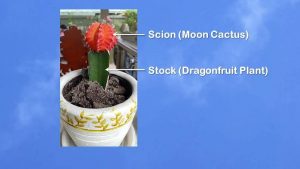
Photo-Practical gardening.com
Usually, grafted plants have longer lifespans. But as the Moon Cactus is a combination of two incompatible cacti, the life span of Moon Cactus is very short.
Gymnocalycium mihanovichii grows only a few inches whereas Hylocereus is a tall cactus that can grow up to 30 feet. The different growth rate of the two cacti shows difficulty in giving the right amount of water to the Moon Cactus. This may not be visible initially. But as Moon Cactus matures, the rootstock starts growing faster.
Despite the difference in height and growth rate, another problem with the Moon Cactus is the different care needed by the two combined plants.
If you want to know how to take care of a Moon Cactus? read our article: https://mitcityfarm.com/how-to-care-for-a-moon-cactus/
Gymnocalycium mihanovichii prefers the shade as it lacks chlorophyll making it vulnerable to sunburn. Whereas Hylocereus needs the full sunlight but it can tolerate partial shade.
Moon Cactus life span
As we all know, most cacti live for many years, but the Moon Cactus has a short lifespan as it is a union of two plants in which one plant behaves as a parasite.
Over the period of time, the rootstock is not able to produce sufficient food for itself and the scion. This weakens both the scion and the rootstock, thus making the lifespan of Moon Cactus short that can vary from a few months to five years.
Why does Moon Cacti need grafting?
Moon Cacti have bright red, pink, yellow, and orange colors that are totally natural and develop in the mutant Gymnocalycium mihanovichii plant lacking chlorophyll, a substance responsible for giving the green color to the plants. As the upper part is deficient in chlorophyll, it cannot make its own food and depends on the bottom cactus for it. Therefore the plants are grafted onto a species that produces sufficient chlorophyll so that the moon cactus can survive for many years.
Any species of cactus can be used to make a colorful moon cactus. Usually, the cactus species Hylocereus undatus is used for the stock in garden centers for the moon cactus.
Moon cactus is called the star- flower cactus as this green cactus has a straight stem with a star-shape on its cross-section. The shape is perfect for grafting the ruby ball cactus on the top.
Moon Cactus Benefits
Moon Cactus is an attractive cactus which can be grown indoors as it purifies air.
Though Moon cactus life span is very short but the Moon cactus is very pretty and it is a small cactus which you will love to have in your collection of plants.
Maintenance & Propagation of Moon Cactus
To keep the moon cactus in globular shape, cut the side shoots. Use the side shoots or the offshoots for the propagation. Use a host plant like Hylocereus undatus which provides a perfect base for the side shoots. Select host plants of the same thickness, height, and diameter.
Prepare the host plant before collecting the offshoots. Cut the top of the host plant at a slant, then cut the offshoots carefully from the mother plant.
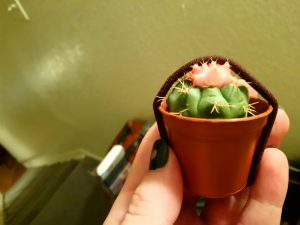
Photo-Reddit
Now press the two cut pieces together by putting the offshoot on the host plant. Press firmly but not very tightly. The cuts of the host plant and the offshoot should not dry before completing the grafting process. Hold the two pieces together by securing the side offshoot with a rubber band.
The offshoot will start growing on the host plant after several weeks. Now you can remove the rubber band and follow the moon cactus care tips.
Precautions while propagating the Moon cactus
While propagating the Moon cactus, the main problem faced by the moon cactus is that it is infested with mealybugs and scales. These infestations can be dealt with by using tweezers, or cotton wool dipped in alcohol. Use an insecticide if it still remains there on the cactus.
Root rot is another common problem which occurs due to overwatering. Be careful while watering your moon cactus.
Moon Cactus Life Span | How long do Moon cactus live?
A Moon Cactus can live from one to three years and have a very short life span. Sometimes this cactus can live for five years or a decade if it is maintained properly under suitable growing conditions. But a Moon Cactus will live for a few months only, if you do not have any experience in caring for one.
It has relatively low maintenance requirements.
Reasons for Moon Cactus Dying
The possible reasons that the Moon cactus is dying are :
- you overwater or underwater your cactus.
- the cactus does not get daily sunlight.
- the cactus is kept in direct sunlight, it will give the plant sunburn marks and can kill the Moon Cactus.
- the soil drainage for Moon Cactus is not proper.
Moon Cactus dying can be identified by the brown, rotting stem that is because of root rot as the plant is either over-watered or has poor drainage or both.
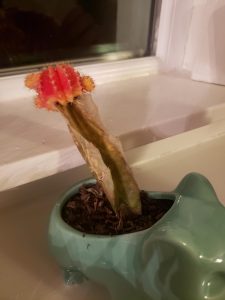
Photo-Reddit
But if the stem is white and firm, you can replant the cactus in a clean pot with new and sterilized soil or relocate it to a new place in the garden.
How to Save a Dying Moon Cactus?
You can save a dying Moon Cactus by cutting off all black or brown mushy roots and by retaining the white and healthy roots.
Then repot the plant in well draining soil and do not water it at least for a few weeks.
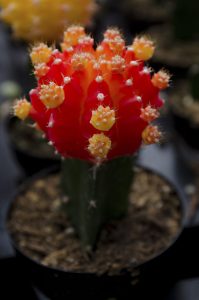
Photo- GardeningKnowhow.com
While watering the cactus, do not water again till the soil is dried completely.
Moon Cactus Benefits
Moon Cactus absorbs Carbon Dioxide, Moon cactus is also called a filter of the environment. But it is also said that growing moon cactus or other cactus in the home can bring diseases, stress, anxiety or losses.
Due to its pretty appearance, it is an excellent choice for any garden. You can put it in window sills after growing it in a small pot.
Conclusions
Moon cacti can be easily grown and it is easy to take care of these small and pretty cacti. You can buy these colorful cacti and add them to your collection of plants. You should add a Moon Cactus to your collection if you are a succulent lover. Easy to grow and care for, they can fill any empty space in your room or your windowsill and will brighten your day.
FAQs
Q. Can Moon Cactus grow without grafting?
As the Moon Cactus is a mutant that cannot produce chlorophyll, so it should be grafted onto a rootstock to provide it with sufficient nutrients. However, while growing a purple Gymnocalycium mihanovichii, separate a few offsets carefully and root them to see if they grow on their own without grafting.
Q. How big do Moon Cactus get?
Moon Cactus can grow up to 10 cm (4 inches ) depending on the rootstock. The width of the top part can be about 3 cm to 5 cm. Usually, they have more or less saw-toothed ribs having narrow fringes that are 8 to 14 in number. These grafted cacti are small in size and are very pretty with a colorful top.
Q. What is the best rootstock for Moon Cactus?
The best rootstock for Moon Cactus will be the one growing well on its roots and that can photosynthesize well. The most commonly used rootstocks for grafting Moon cactus are Hylocereus undatus, Cereus Peruvianus and Trichocereus spachianus.
Q. Can you keep Moon Cactus indoors?
You can keep Moon Cactus indoors however, make sure to keep them at a place where they can get bright but indirect sunlight. Moon Cactus needs both sunlight and shade to survive as it is a grafted cactus, a combination of two plants. In winters, it is better to keep them indoors to save them from frost.
